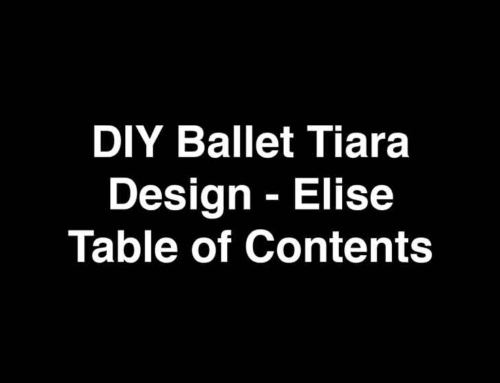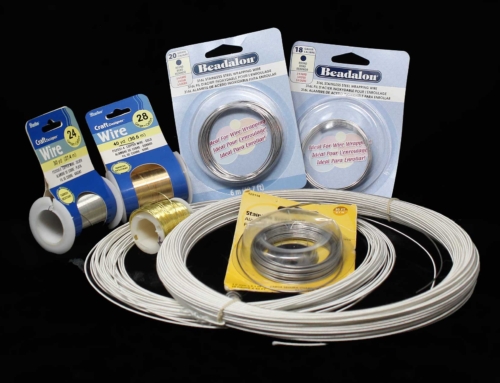DIY Ballet Tiara Inspiration & Designers
I started DIY ballet headpieces mainly out of selfishness. As much as I love the rhinestone chain headpiece, after making two or three of one design, it is a little soul-sucking to continually repeat the same thing over and over again. It is my goal to find designs that you guys can make and provide that information and instruction to free myself to create new designs. Much like the world of tutu making, there are very few skilled in the craft of making headpieces for theatre. I wanted to share with community the techniques–there are several and none of them represents the defacto “right” way to create them. Each technique has an advantage and disadvantage.
I am sharing with you the top makers and designers I know for inspiration. These people are my favorites, or they represent how I was introduced and developed my techniques. Yes, there is a pros and cons section; however, do not construe that to mean there is something wrong with a maker’s designs or methods. The attitudes I express are opinions. Just because I find a design clumsy or not visible at the back of the theatre does not make it wrong. It depends on the situation. I might prefer one construction method over another because of its neatness; but in all actuality the neatness of a design is not visible from stage. A little glue glob around the edge of a stone or a glue glob line on the back of a tiara might be unsightly, but it will make the stone stay longer or prevent the wire from coming loose or breaking over time.
My work can be pro’ed and con’ed in the same manner. I do this with each piece I create. It gets critiqued; I evaluate; and make changes to designs or construction methods as I continue. Many of the comments I provide in this section are the same things I say about different designs I have made. I will say: I love this, but it will not translate to the stage; it is too small, too detailed, or overly complex. I could critique my gluing method as unsightly, but I know if will prevent any accidental breakage. I use several construction methods. I hope to offer tutorial for each of these methods in the future.
Please be warned: Some of the artists below will be extremely offended if you copy their look, style, or designs outright. I do not endorse outright copying these artists. Although, I do believe some design shapes used by some are too generic not to breach that look or style threshold that might upset. On a personal level, I am indifferent to being “copied.” You can read my whole series on inspiration, copying, and copyright through these lengthy blog posts: Copyright Series. My opinions are not popular.

Snow Queen Design by tutu.com.
View this post on Instagram
I had been making The Tudors inspired filigree tiaras for several years and after much pressure from my friends in the ballet community, I decided to start making tiaras more suited for dance. My first thought was to go to tutu.com because of their reputation for being the go to shop in the industry. They offer patterns from which you can form your own frame; they offer these frames pre-built; and, they offer the whole kit with instructions.
The first kit I ever bought was from tutu.com, and it was their Snow Queen design. Their designs use silver-corded millinery wire in a rather thick gauge, which makes it hard to bend and make intricate shapes (pros and cons). Their Snow Queen (also modified as a Dew Drop) design is the only one I’ve seen using rhinestone cup chain. Instead, they use rose montees, which are flat and have a crisscross channels on the back usually in 20ss or 30ss stone sizes. They weave these stones into a “chain” and then wire this chain to the millinery based frame. The effect may look messy upfront, but its results on stage are spectacular. Their instructions include a method of securing wires and such to the frame by using hot glue. I am not a fan of this: it looks gloppy; its ugly; it is difficult to get out the right amount of glue; you might burn yourself. And, if you haven’t picked a high heat hot glue gun and glue, you will not get the results you want. It will come unattached.
Unconfirmed thoughts: the rose montee style construction of headpiece I believe to be inspired by the techniques by Kellie Sheehan (New York City Ballet). The folks at tutu.com have used this technique to make many looks. I don’t know this for fact, but the use of rose montees is definitely used in NYCB headpieces and tutu.com’s princess pattern credits Sheehan as the designer.
Pros:
Cons:
View this post on Instagram
View this post on Instagram
Svetlana’s work is currently my most favorite and inspiring designer. I’m obsessed with the intricate designs and the textures represented in her pieces. I had seen her work through some Google image searches — probably landing on Pinterest. I never knew it was her work I was admiring for years until I found her on Instagram and made the connection. I have seen numerous international companies wearing her headpieces (once I figure out their names again I will post them here). I’ve also seen her work on Elena Sharipova, currently principle with the Ural Opera Ballet Theatre, Anna Germizeeva, current principle with the Novosibirsk Opera and Ballet Theatre, and Iana Salenko, currently principle with the Staatsballett Berlin.
It is difficult for me to comment on her work because, unlike everyone else on this page, I have not seen or held her work in my own hands. I have seen a series of images she posted showing the steps she goes about constructing her headpieces, and I have seen videos of her headpieces on stage. In her process post, I saw her start with a drawing then use bare wire to build out the design — usually from the center out — adding beads or rhinestone chain as the design as it is built. When a bead is unsupported and is floating at the bottom when it should be at the top, it is moved to the top by wrapping string (like embroidery thread) until the bead is at the top and the wire support is covered by the thread. After the whole design has this threaded material wrapped around all of the support wires, she applies an acrylic to the back of the headpiece along with glue. I can tell you from personal experience, that hand wrapping a tiara with thread is a super tedious task. It does have benefits and with these designs it is imperative as it makes multiple wires one solid piece — adding strength — especially when the tread is painted over with an acrylic.
I can tell from the beads that the wire used is not super strong. and in some of the videos you can see how her pieces jiggle a bit. This is indicative of a 20 gauge or less wire being used. So these are not rock solid pieces like a work hardened piece. As I mentioned in my wire guide, you do not have to use work hardening to make professional headpieces. Your designs simply need to be supported by other elements to provide stability. Having a bit more flexibility also makes it easier to conform to a dancers head. I love her use of beads protruding from the tops of rhinestone cup chain. I have done this myself, but always question how secure this bits will be over time.
View this post on Instagram
View this post on Instagram
Pros & Cons:
I am not comfortable doing a pro and con section because I haven’t seen her work in person. As a craftsman, the process she uses allows a great amount of design flexibility. You can do SO MUCH. However, it is a very time consuming process. I have tried a few headpieces using this process. It takes a huge amount of patience and a lot of skill. It is the hardest method in making a headpiece, but its results — at least in the hands of Svetlana — is spectacular.
View this post on Instagram
View this post on Instagram
Marta is located in Spain. Aside from being a talent milliner, she is also a phenomenal corset and fashion designer. I first found Marta from an internet search for ballet headpieces. The first image was my introduction to her work. She is one of the more creative ballet tiara makers out there — combining jewelry making techniques with aluminum components beads and now rhinestone cup chain. There really isn’t another designer out there doing what she is doing. And though there are people out there that will tell you, you can’t make ballet headpieces with aluminum; I’m here to tell you, you can! I’ve held in my hands her headpieces, and they are very well constructed. Her pieces gain strength from intelligent base construction and using a single wire upper component. If there are separate pieces used in the design ,they are well connected with adjacent components. Granted, you wouldn’t want to toss this headpiece in a dance bag or accidentally sit on it, but in my opinion no one should be treating any headpiece like this. The intricate design does get lost on stage, and without using larger rhinestones components, the sparkle doesn’t pack a punch in larger theaters.
Pros:
Cons:


Another unique artist who is from Brazil. I have experience seeing this artists’ headpieces in person. Her designs are built on a sturdy band with combs attached to them and include elastic ties to help secure to the head. Her filigree/swirl designs appear to be built from a thick, sturdy craft paper well protected from moisture with acrylic paint — sort-of-like decoupage. These pieces then become shapeable because the top design is backed with a wire and the wire has been covered over by gluing felt pieces. So the structure is: top paper design – wire – felt. It is a very versatile and unique construction. Although, I personally know these headpieces to be worn by smaller companies, and they have held up well; I am uncertain how well the paper-based product would last under extreme vigorous use — lots of sweat without time to dry out. It seems okay for a weekend of performances over the past four or five years. These pieces are extremely light weight, as all the adornment in the pieces I have access to use plastic beads, drops, and lower-quality rhinestones. While this makes the piece light-weight, its bang on stage is less impactful.
Pros:
Cons:
View this post on Instagram
View this post on Instagram
View this post on Instagram
Caryn was the wardrobe mistress for American Ballet Theatre for 18 years. You can find her headpieces worn by ABT, Miami City Ballet, Charlotte Ballet, as well as Broadway shows like Anastasia. She is best known for her swirl design pattern seen as in the first image. I became acquainted with her work from pictures of Gillian Murphy–who is pictured wearing this design. I have recommended her work to others when I am unable to make headpieces, which means I have also seen and held her work in my hands. Her craftsmanship is exemplary
She uses a work hardening technique in the construction of her headpieces. This means her headpieces are super strong and the design elements are difficult to bend. Super strong/stiff designs can have issues with usability — this is discussed in my wire guide. She loves to use vintage jewelry pieces in her designs in order to provide uniqueness to each design. The sparkle factor varies for her pieces. It really depends on the size of the chain she uses and the number of larger stones in the piece. Rhinestone chain based headpieces that have a lot of open air also tend to disappear on stage–giving a barely there appearance, and smaller rhinestones leave a slight sparkle on stage instead the flash needed to telegraph to the back of the theatre. I go over this in my rhinestone selection article; there is a difference in shiny, sparkle, and flash.
Most of her headpieces are fantastically — and deceptively — simple (that is good) and are usually recognizable in the scroll, “S” shape motif in various configurations. Although, she has produced other lovely designs in a pointed tier shape and her simple diadems–pictured in the second image. You will find her diadem design donned by numerous competitors at YAGP. My favorite design of hers is the last image shared.
Here are some videos in which her work appears:
- Charlotte Ballet — Snow Queen — Sugar Plum Fairy
- Kansas City Ballet — Snow Queen — Sugar Plum Fairy — Sugar Plum Pas
- Miami City Ballet — Sugar Plum Fairy — Dew Drop Fairy
- Miami City Ballet — Tchaikovsky Piano Concerto No. 2. — long blue dress/principle in white — all ladies headpieces
- Gillian Murphy — Sugar Plum Fairy Guesting
Caryn is super sensitive about being copied – or seeing works she feels is a copy of her work. If you are inspired by one of her designs and do not want to offend this well-known designer, I would encourage you to reach out to her and get her permission to do a derivative work.
Pros:
Cons:
Two others
I have two others to add to this list, but I am currently doing research. One is a beaded tiara maker — the other is a Japanese based maker. I’ll let you guys know when I have updated to include these two.
Other people to check out
People to follow on social media. These are people who are either in the professional theatre business or creators of headpieces I find inspiring.
I had the opportunity to take his tiara making class at a tutusthatdance seminar. His craftsmanship and design esthetic is bar none. He is the former Wardrobe Master at Opera Australia and has moved on to other greater horizons. The listing here isn’t a reflection of talent, rather, an uncertainty if he is still working in the biz. I learned from his class how to construct a millinery base wire form for a tiaras, which I have used in a few designs since as well as the general concepts regularly.
I follow Dean on Instagram. If you go there, you will find many tiara/headpiece treats to look at — from hats to tiaras worn by the Royal Ballet.
Erica Johnston — Pointe Creations
I found Erica on Instagram. Her headpieces are quite unique; although, I don’t know if she still produces them regularly for sale. Currently she is a costume designer in New York.
….I will be adding to this list…there are at least two people I can think of, but I don’t have their info at hand to add.





